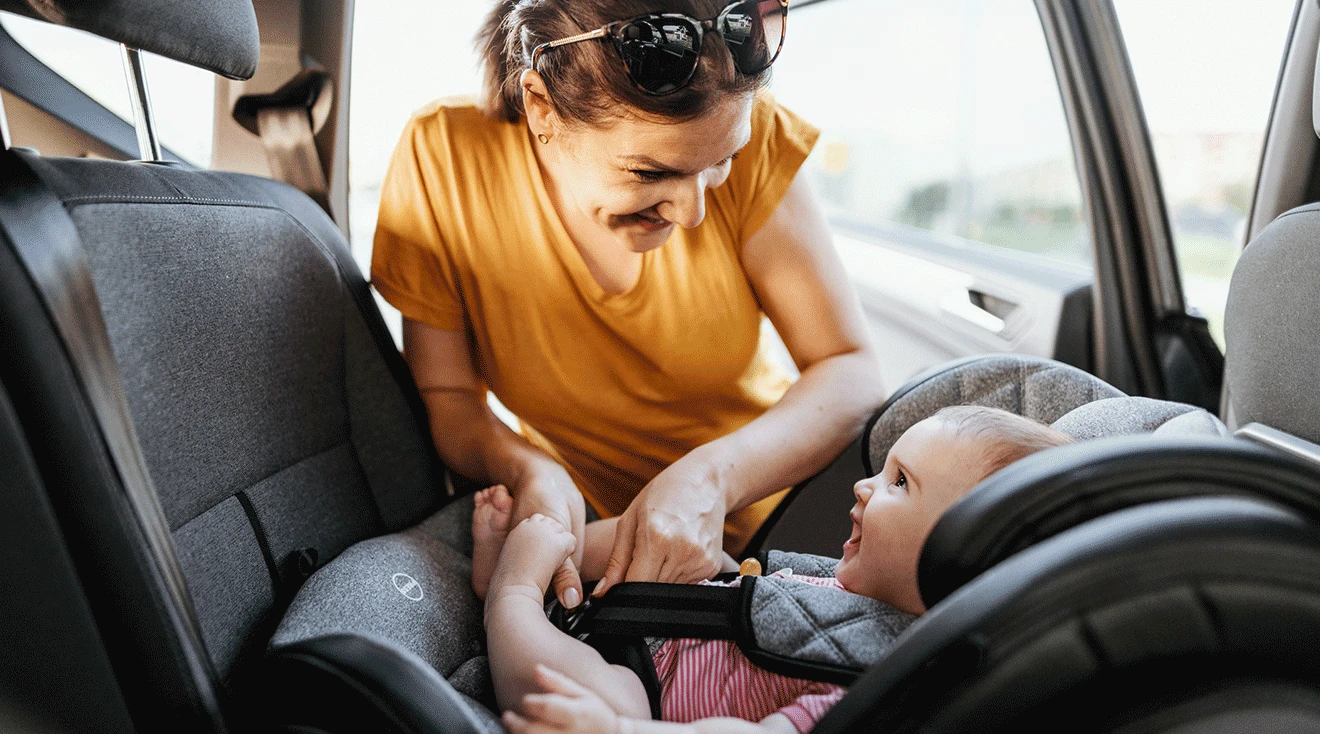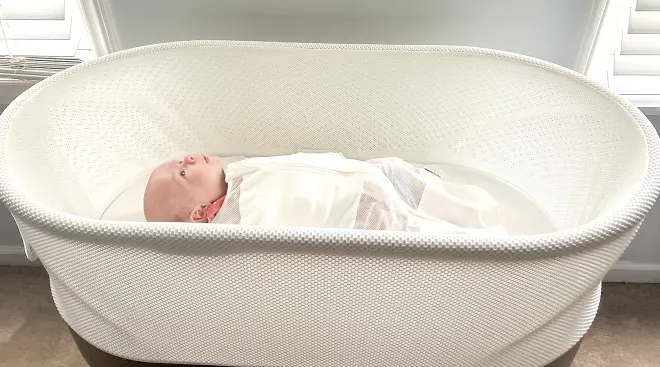The 7 Best Infant Car Seats, Based on Parent Testing
In a nutshell:
Based on our hands-on product testing, survey feedback from over 300 members of The Bump community and advice from a child passenger safety expert, we chose the Nuna pipa aire rx + pipa relx base as the overall best infant car seat thanks to its impeccable safety ratings, lightweight build and convenient features.
Keeping baby safe on the road is the very top priority of any parent who drives. (As a mother of two, I’d know!) While every family wants to find the best infant car seat out there, the dizzying array of features designed for both safety and convenience can make the decision daunting. Between latch hooks, load legs, belt paths and rethread harnesses, where should you start?
Feeling stressed? Take a breath. According to Joshua Dilts, lead car seat product manager at Chicco and a father of three, “all car seats on the market must meet US federal safety standards.” That means that by law, any new model you buy will be sufficient to do its primary job of keeping baby safe. You’ll just need to pick the option that will work best for your family—and that’s where we come in. We’ve recruited a team of parents with young babies to rigorously test a range of car seats. We’ve assessed how they meet real-life parent needs as well as analyzing how they’ve performed in safety and crash testing to identify our top picks for the best baby car seats—including this year’s Best of The Bump winners.
The Bump editors conducted extensive research to identify 22 of the top-rated infant car seats on the market, and chose a shortlist of 17 standout products to test. From there:
- We enlisted 17 parents of babies 5 months and younger to test our top picks to see how they held up in real-life scenarios. These parents installed the car seats in their own cars, strapped their babies in and out of the seats and took them on long and short rides. After extensive hands-on use, they evaluated each product and gave it a score out of 10 for each of the following categories: ease of installation, ease of use, ease of carrying, features and design, value for money and, of course, safety.
- We surveyed 300 parents of The Bump community and asked them to rate the infant car seats they’ve used with their own kids, and to comment on their overall experience.
- We interviewed an expert in car seat safety and asked for tips on what to look for and how to safely install an infant car seat in your vehicle.
- We checked scientific research and recent law changes regarding car seat safety, consulted crash-test ratings from Consumer Reports and followed advice from the American Academy of Pediatrics (AAP), National Highway Traffic Safety Administration (NHTSA) and other expert sources.
- To see how these infant car seats worked for a variety of families, we conducted exhaustive market research, scouring forums and message boards and reading user reviews to find out what parents value in a car seat.
Editorial integrity is at the heart of everything we publish. Read about how The Bump develops and reviews all articles, including product reviews.
Overall best infant car seat
- Easy installation
- Load leg and anti-rebound panel
- Naturally flame-retardant, without added chemicals
- GREENGUARD-Gold certified
- Expensive
- Lower than average weight maximum
Some seats just do it all. The Nuna pipa aire rx is the kind of product that spoils a parent, loaded with features that address nearly every complaint families commonly have about car seats. Our tester Noora certainly agreed, awarding the Nuna pipa aire rx 10 out of 10 across all categories. So what exactly makes this infant car seat worthy of a prestigious Best of The Bump award for overall best infant car seat?
First and foremost, Noora described the safety features as “excellent,” and we’re inclined to agree. It’s got a 17-position built-in load leg to ensure a perfect fit in any backseat—including the middle—whether you’re using the base and LATCH or using the European belt path to secure the seat directly into an Uber or cab. “I feel so comfortable with the sturdiness of the car seat. I love the way it sits in the truck and the extra security features and latches that are on the base to secure it to the seat and belts,” Noora says. What’s more, an anti-rebound panel and side impact protection make the seat ironclad, which is perhaps one reason why independent crash testing conducted by Consumer Reports found that it offered the “best” level of crash protection available.
Installation is “simple and easy,” Noora reported, thanks to a button-operated four-position recline that eliminates the need to use those tedious balance bubbles that other seats rely on. Plus, Nuna’s True Lock installation includes steel-reinforced LATCH connectors that flip out from the base and turn green when properly connected to the car. When it comes to securing the child, this model’s makers have thought of everything, from a no-rethread harness to magnetic buckle holders—no more wishing you had an extra hand, or digging underneath your baby’s bottom to find the strap and clip them in securely.
Other perks of this model include the breathable, stain-resistant fabric and an extra liner that you can insert when the other one is in the wash. The seat itself is super lightweight at just 8.4 pounds with seat inserts and canopy included. Noora says that “the weight distribution makes it so easy to carry,” praising the adjustable handle, and adding, “It’s so simple and easy to convert and carry with baby inside or without.” And don’t forget about Nuna’s magnetic Sky drape canopy, which covers the full seat for on-the-go naps.
Feature after feature, the pipa aire rx just keeps delivering, resulting in a car seat that makes things as easy as possible for parents, while still providing them with total peace of mind. And Noora’s final takeaway? “It’s awesome and we love it!”
Dimensions: 27.3" (L) x 17.5" (W) x 23" (H) | Weight (seat with inserts and canopy): 8.4 lbs. | Weight (base): 16.8 lbs. | Weight capacity: 30 lbs. | Height limit: 30" | European belt path: Y
Our product tester says:
“I would recommend this car seat to anyone looking for security and comfort all in one car seat. We’ve tried two other infant car seats that are very high quality and this is the best by far!”
Best infant car seat with additional safety features
- Safety sensor clip
- Load leg and anti-rebound base
- Full recline in stroller
- Naturally flame-retardant, without added chemicals
- High price point
- Lacks a non-slip handle grip
- Heavier than alternatives
Every parent wants the safest infant car seat for their baby, and while every option on the market is subject to federal standards, some models, like the Best of The Bump-winning Cybex Cloud G Lux, go above and beyond with an array of additional safety features.
The seat is equipped with an anti-rebound base and load leg, as well as linear side impact protection. On top of that, The Cloud G Lux features a Bluetooth-enabled clip that pings your phone when it becomes unbuckled, whenever the seat gets too hot or cold or even, in a worst-case scenario, if you accidentally leave your child in the car. “The SensorSafe Technology is such a great tool,” says our product tester Kareene. “The fact that it can tell you if the chest clip is undone or if the seat is too warm or too cold blows my mind!” It’s no wonder, then, that she gave this infant car seat a 10 out of 10 for safety.
The attention to safety doesn’t stop in the car, though: When attached to a stroller, the seat tilts backward 45 percent more than comparable infant car seats. This offers a stable sleep surface for newborns and infants. “The full recline position is so unique and is a great selling point,” Kareene said, adding that it was “so convenient to change the recline when baby falls asleep during our walk.”
Luckily for littles, the seat’s not just safe—it’s comfortable. Kareene, awarding the Cloud G Lux another 10 out of 10 score for features and design, described the fabric as “really soft and cushion-y.” What’s more, the seat back is designed with air vents to promote temperature regulation. And an extra-large UPF 50+ canopy helps ensure naps on the go are restful, since it really blocks the sun without compromising portability. “I like that the carry handle sits high when the canopy is extended so that I can easily slip my arm through to carry the car seat on my forearm,” Kareene shared.
With eight color options, the seat aligns to any aesthetic. But what’s style without ease of use? Rest assured, it’s another area where the Cloud G Lux earned a perfect score. “Love that it has a no-rethread harness, and I appreciate how easily the harness glides to tighten it,” our tester shared, fully convinced this seat’s got it all—including a whopping 12 headrest positions to keep your child safe and secure as they grow.
Dimensions: 26.5" (L) x 17.6" (W) x 15.8" (H) | Weight (seat): 12 lbs. | Weight (base): 16 lbs. | Weight capacity: 4 to 35 lbs. | Height limit: 32" | European belt path: Y
Our product tester says:
“The safety features that come with the car seat and base make it worth the price. It's beautifully designed.”
Best infant car seat for crash testing visibility
- Transparent, impressive crash testing results
- Load leg
- Narrow footprint
- Extendable sun shade
- Doesn’t have a no-rethread harness
- High price point
Not every car seat manufacturer publishes their crash testing results, but Clek posts their results for the Liing infant car seat on the brand’s website. And we have to say, it fared impressively well on impact across the board, particularly for preventing head injury. But you don’t just have to take their word for it—Consumer Reports also gave this Best of The Bump winner the best possible rating for crash protection.
The Liing offers up to seven recline positions, plus additional safety features such as side impact protection and an energy-absorbing metal load leg that even works in the center seat. “I was admittedly skeptical about the stabilizing [leg], worried it would take up valuable floor space in front of the seat, but it didn’t obstruct the area and provided additional peace of mind,” our product tester Kimberly said, giving the Liing 10 out of 10 scores for safety and features and design.
Aside from its top safety features, the Clek Liing is nice and narrow at just under 17 inches wide. Our product tester reported that this seat fit easily into her car alongside her toddler’s rear-facing seat—with plenty of room to spare for another car seat or passenger in between. Kimberly also raved about the seat’s retractable overhead shade, which “extends farther than I have seen with other car seats,” she said. Conveniently, the shade also includes a flap that can be pulled back to check on baby, and it provides additional ventilation.
Overall, “the design of the seat itself is wonderful,” reported Kimberly. “The fabric and cushioning is very soft and makes for a very comfortable ride, and the headrest has just the right amount of support to allow for my daughter to safely sleep in the car as we drive.”
Dimensions: 27.7" (L) x 16.9" (W) x 26.8" (H) | Weight (seat): 9 lbs. | Weight (base): 17 lbs. | Weight capacity: 4 to 35 lbs. | Height limit: 32" | European belt path: Y
Our product tester says:
“The seat seems incredibly safe with the stability /[leg]. It was easy to initially install, has incredibly soft and comfortable fabric and includes an extendable shade that zips up when not in use. Overall, the design of the seat itself was wonderful!”
Best narrow infant car seat
- Slim design
- Anti-rebound bar
- GREENGUARD-Gold certified
- Generous legroom
- Canopy can obstruct handle adjustments
Car seats can take up quite a bit of room in your back seat, and for families with multiple little ones, situating them all in the car can be a bit of a headache. Fortunately the Chicco KeyFit 35 Zip ClearTex Infant Car Seat, our Best of The Bump winner for best narrow infant car seat, is designed with a slim profile, so you can install multiple car seats side-by-side and ensure every member of your growing family is safely secured. At 16.5 inches wide, the KeyFit 35 Zip is the narrowest infant car seat on this list (by almost two inches, in some cases). And while it isn’t the absolute narrowest seat on the market, we believe it’s the best option in this category due to its slim profile paired with impeccable safety features and a lower price point than its big-name competitors. (After all, you don’t want to sacrifice overall performance just for smaller dimensions). But narrow doesn’t mean a tight fit for your child. Our product tester Samantha found the seat was roomy for her baby, saying,”My baby seems very comfortable in the car seat, so comfortable he barely cries in this one and falls asleep in the car so easily. He has a lot of room to grow, with the headrest moving up higher and the space/length around his legs.”
This top infant car seat’s features include an extendable, five-position headrest that grows with baby, and an easily-adjustable no-rethread harness. “Getting baby in and out of the car seat is simple and straightforward, and the straps were smooth to loosen and tighten,” Samantha told us, giving the KeyFit35 Zip 10 out of 10 scores for ease of use. She also gave top marks for ease of installation, thanks to the premium LATCH connectors, a SuperCinch force-multiplying tightener, a spring-loaded leveling foot and a steel-reinforced belt system for installing without the base. In other words, you won’t need a degree in engineering to ensure baby is strapped in properly.
Our product tester gave the KeyFit 35 Zip top marks for ease of carrying, telling us it was “on the lighter side compared to other car seats, and the handle is comfortable to hold.” Plus, the UPF 50+ extendable canopy will provide important sun protection when you’re on the go. It was also a hit with our survey respondents—Taylor, a mom of one, told us she liked the “safety features, ease of use and carrying” options.
Dimensions: 28" (L) x 16.5" (W) x 24" (H) | Weight (seat): 10 lbs. | Weight (base): 8.5 lbs. | Weight capacity: 4 to 35 lbs. | Height limit: 32" | European belt path: Y
Our product tester says:
“My baby seems very comfortable in the car seat, so comfortable he barely cries in this one and falls asleep in the car so easily.”
Best rotating infant car seat
- 180-degree rotation
- Load leg
- Full coverage canopy
- Naturally flame-retardant, without added chemicals
- Weight limit is lower than average
- Rotation may not work when installed next to another car seat
If you’re under the impression that a rotating infant car seat would weigh a ton, think again. New to the market (but already our Best of The Bump winner for best rotating infant car seat), the Maxi Cosi Peri 180 Rotating Infant Car Seat weighs under nine pounds without its base, and the brand claims that it’s the lightest rotating model out there. The ability to rotate 180-degrees on its base can be a game changer if you’ve got back issues or simply don’t feel like contorting yourself when it’s time to clip baby in and out of the back seat. Our product tester Ashley said this feature is “definitely a luxury,” but added that she “absolutely loves that it rotates” as it helps make it even easier to unbuckle her 4-month-old.
Aside from its ability to rotate, Ashley, who is a mother of three, is a big fan of this seat for a slew of additional reasons. Installation is a breeze thanks to the easy-to-attach LATCH connectors and a unique red-to-green indicator that monitors belt tension for you. “The car seat was so easy to install!” our product tester gushed. “Especially with the LATCH feature. It probably took less than five minutes to install that way,” she continues. Once it’s in place, Ashley reports that “it’s very easy to remove from the base.” She was concerned that the carrier lifts a bit off the base a little when installed correctly; however, we confirmed with the manufacturer that this design is intentional and doesn’t compromise the seat’s safety. Plus, this rotating car seat features a load leg, which Ashley loved, saying it “felt like an extra layer of safety.”
Down the line as baby grows, adjustments are just as turnkey as initial installation. Ashley especially liked the no-rethread system, five recline positions and the extendable canopy that secures with magnets to provide full coverage.
It’s important to note that, as the 180-degree rotation takes up a fair amount of space, you may not be able to use the spin feature when installed next to another car seat—a disappointment for Ashley, since she liked the swivel feature most. But all in all, she was a big fan of this infant car seat and would recommend it to other moms with a healthy budget. “This seat is worth the price considering the brand and quality of the seat,” she declared.
Dimensions: 29.5" (L) x 18.125" (W) x 28.5" (H) | Weight (seat with inserts and canopy): 8.5 lbs. | Weight (base): 6.9 lbs. | Weight capacity: 30 lbs. | Height limit: 32" | European belt path: Y
Our product tester says:
“I absolutely loved the rotating feature of this car seat! I have experience using a rotating convertible seat, but not an infant seat so this was so nice. The rotating part was very smooth and easy to maneuver.”
Best budget-friendly infant car seat
- Affordable price point
- Lightweight seat
- Easy installation
- Stimulating design of canopy lining
- Doesn’t have a no-rethread harness
- Lacks cushioning around baby’s head
A high price tag on an item you can only use for a limited number of months can sometimes be hard to swallow. If you’re looking for a cheap infant car seat that makes no compromises on quality, the Graco SnugRide 35 LX might be the choice for you. Standard features of this affordable (and Best of The Bump-winning) infant car seat include an adjustable base with a pendulum level indicator that assists with proper installation and adjustments as baby grows. A rotating canopy can be positioned just right to block the sun at any angle—an especially nice feature for when you clip the seat into any Graco stroller and take baby for a walk.
Our tester Steph told us the car seat was “very easy to install using LATCH. It took less than 10 minutes to install it properly and it felt very secure once it was in place.” Giving the SnugRide 35 Lite LX a top rating for ease of installation, she noted that “the seat itself was also easy to click and unclick into the base.” Removing the base to switch cars didn’t take much muscle either. “The most difficult part was loosening the strap, but frankly I was glad because it meant it was very secure in the first place.”
The seat’s roominess earned it a 10 out of 10 rating for ease of use from our product tester, who told us, “despite the name SnugRide, the car seat feels wide, which is great for my big baby!” Describing it as “well-designed” and “easy to use,” she added, “I had no issues getting him in and out of the seat, which is definitely not the case with other infant car seats.”
Her son particularly liked the black and white pattern lining the interior of the sun canopy, a design feature in select colors: “He appreciated the black and white contrast and would stare at it a lot.” In fact, our product tester gushed, “My son actually preferred this car seat to his much more expensive convertible car seat that we've been using since birth! I would've bought this one from the beginning if I'd known.” Safe to say this model is mom and baby approved.
Dimensions: 18.1" (L) x 15.5" (W) x 27.4" (H) | Weight (seat): 7.5 lbs. | Weight (base): 4.8 lbs. | Weight capacity: 4 to 35 lbs. | Height limit: 32" | European belt path: Y
Our product tester says:
“It is a really affordable seat and is definitely worth the cost. Since it was so cheap, I was a bit worried it wouldn't be that safe, but I found it to be a really great car seat overall.”
Best infant car seat/stroller hybrid
- Functions as a car seat and travel stroller
- Easy to convert between the two formats
- Anti-rebound bar
- Convenient for travel
- Lacks storage basket
- High price point
- Heavier than non-hybrid models
- Doesn’t have a no-rethread harness
One of the main benefits of using an infant car seat is being able to lift it out of your vehicle without disturbing baby. Of course, nobody said it would be easy to carry a baby in a car seat any farther than the distance between your vehicle and the curb. Enter: The Doona, an infant car seat equipped with wheels to transform it into a stroller (and back again). To switch to stroller mode, simply squeeze a lever at the back and watch in awe as wheels pop out. Our tester Juanita immediately appreciated this unique design: “I never have to carry it,” she said delightedly.
You might worry that this innovative style would be difficult to set up and use, but Juanita found installation to be quite simple: “The instructions were very clear,” she shared. “It took around five minutes to install and it felt very secure once the base was in place.” Once it was set up, she says taking baby out and putting him back into the seat was extremely easy. “He felt so snug and secure in there. The harness is very easy to adjust and tighten—he looks and feels very comfortable.”
Stylish, modern and instantly recognizable, this model comes in seven color options. But it was also designed with safety at the forefront: The hybrid stroller car seat has three layers of side impact protection, plus a handle that doubles as an anti-rebound bar. Small surprise that our product tester gave the Doona 10 out of 10 for safety.
Perfect for parents on the go, this model is the ideal travel infant car seat, since it’s approved for use on airplanes, and—best of al!—it eliminates the hassle of packing both a car seat and a stroller. After using this stroller, Juanita’s main concern was that her son would eventually have to grow out of it.
Dimensions (open): 17.4" (L) x 32.3" (W) x 39" (H) | Dimensions (folded): 17.4" (L) x 26" (W) x 22.4" (H) | Weight (seat): 17 lbs. | Weight (base): 10.4 lbs. | Weight capacity: 4 to 35 lbs. | Height limit: 32" | European belt path: Y
“I would recommend the Doona to new moms. […] It’s useful for someone who doesn’t want to travel always with a stroller and a car seat. This makes it so much easier to take in and out and fits perfectly in a lot of different size cars.”
Our community says:
At a high price, this car seat was absolutely worth it as it also converts to a stroller. It’s comfortable for my baby and I never have to carry it since it can be in stroller mode. I appreciate the minimalist design. – Leah, mom of one and The Bump survey respondent
Infant Car Seats Comparison Chart
| Overall best infant car seat | Best infant car seat with additional safety features | Best infant car seat for crash testing visibility | Best narrow infant car seat | Best rotating infant car seat | Best budget-friendly infant car seat | Best infant car seat/stroller hybrid | |||
|---|---|---|---|---|---|---|---|---|---|
Overall Best  Nuna pipa aire rx + pipa relx base |  Cybex Cloud G Lux with SensorSafe infant car seat | 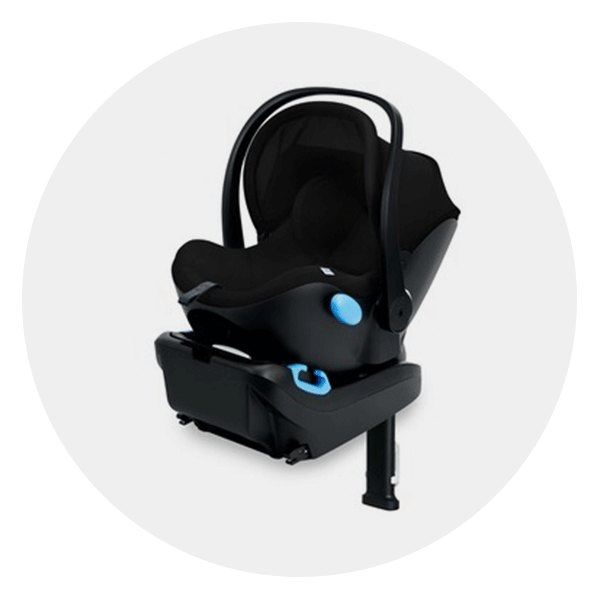 Clek Liing infant car seat and base | 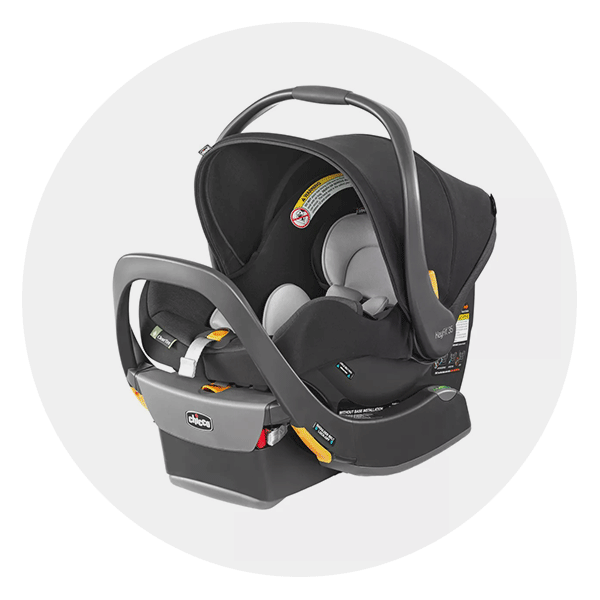 Chicco KeyFit 35 Zip ClearTex Infant Car Seat | 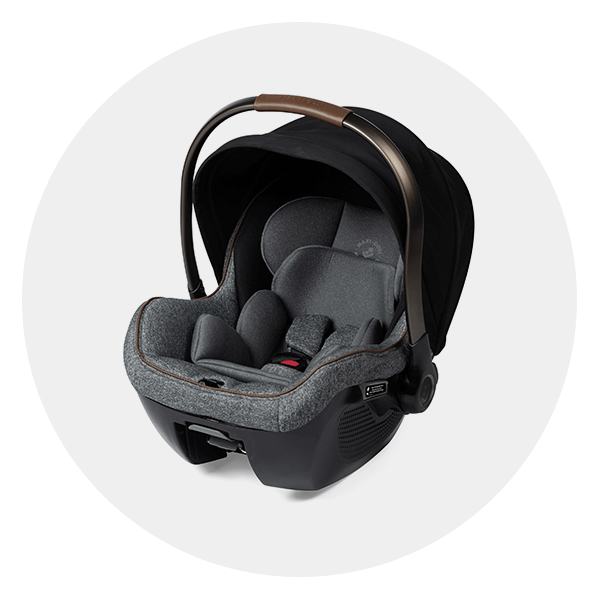 Maxi Cosi Peri 180 Rotating Infant Car Seat |  Graco SnugRide 35 Lite LX Car Seat |  Doona Convertible Infant Car Seat/Stroller | |||
| Price | $550 | $449.95 | $499.99 | $229.99 | $449.99 | $119.99 | $550 | ||
| Dimensions | 27.3" (L) x 17.5" (W) x 23" (H) | 26.5" (L) x 17.6" (W) x 15.8" (H) | 27.7" (L) x 16.9" (W) x 26.8" (H) | 28" (L) x 16.5" (W) x 24" (H) | 29.5" (L) x 18.125" (W) x 28.5" (H) | 18.1" (L) x 15.5" (W) x 27.4" (H) | 17.4" (L) x 32.3" (W) x 39" (H) | ||
| Seat weight | 8.4 lbs | 12 lbs. | 9 lbs. | 10 lbs. | 9 lbs. | 7.5 lbs. | 17 lbs. | ||
| Weight capacity | 30 lbs. | 4 to 35 lbs. | 4 to 35 lbs | 4 to 35 lbs. | 30 lbs. | 4 to 35 lbs. | 4 to 35 lbs. | ||
| No rethread | |||||||||
| Use without base | |||||||||
| FAA approved | |||||||||
| Buy NowRead Full Review | Buy NowRead Full Review | Buy NowRead Full Review | Buy NowRead Full Review | Buy NowRead Full Review | Buy NowRead Full Review | Buy NowRead Full Review |
The Bump is thrilled to partner with Consumer Reports to highlight its in-depth product information and recommendations. Together with one of the most respected nonprofit organizations in research, testing and advocacy, we’re offering key insights about products you can trust for your growing family. See CR’s lab test ratings for The Bump’s recommended car seats below. Join now to unlock 100+ car seat ratings and reviews!
All car seats are designed to protect children from injury during vehicle collisions, but an infant car seat is specifically designed for the youngest babies. According to the National Highway Traffic Safety Administration (NHTSA), an infant car seat is a small, portable seat that can only be rear-facing. Babies can use an infant car seat from birth until they hit the seat’s height and weight requirements; typically, infant car seat height restrictions are capped at around 32 inches with a maximum weight capacity of about 35 pounds. While all children develop on their own schedule, the average baby will reach 32 inches when they’re around 12 to 18 months old, and most tots will hit the height limit before the weight limit.
Regardless of how quickly your child outgrows their first car seat, guidelines from the American Academy of Pediatrics (AAP) specify that children should remain rear-facing until they’ve reached the car seat’s max height or weight limits for that mode; most convertible car seats can be used rear-facing until kids are at least 2 or 3 years old. To that end, you’ll need to decide whether to buy a rear-facing infant seat or opt for a convertible car seat that can be used in a rear- and forward-facing position. Decisions, decisions!
Infant car seat vs. convertible car seat
Infant car seats have a unique benefit: They can be separated from their base and carried with a handle, so you can move a sleeping baby in and out of the car without much disruption. If you have a travel system stroller, you can also click an infant car seat straight into the stroller without having to take your little one out.
You can also use some infant car seats without their base, using just the seat belt; this means you can easily use them in multiple cars or strap them right into a taxi or rideshare as needed. Importantly, infant car seats are specifically designed for younger and smaller babies, often providing a more comfortable fit than convertible car seats.
All that said, some parents opt to skip the infant car seat and go straight to a more versatile convertible car seat. While the latter is heavier and less mobile, it can be used both rear- and forward-facing and has a higher height and weight limit (often 65 pounds and up), so you can use it for several years after installation.
With a seemingly endless range of price points and features, infant car seat options can be overwhelming. Here are the factors and features to take into consideration when shopping for the best infant car seat for your child:
- Ease of installation. While most of the best baby car seats come with impressive safety features, “to perform as designed, they need to be installed properly,” Dilts warns. That means your primary goal should be to select a model you can confidently install correctly every time you use it. Features such as leveling indicators and LATCH (Lower Anchors and Tethers for Children) connection systems can help a novice achieve an A+ installation. For an added layer of evaluation, check out the NHTSA’s car seat ratings. They evaluate infant car seats on their ease of use, taking into consideration the instructions, installation features, labels and child restraints.
- Recalls. The NHTSA can also be a great resource here. Check the website for any recalls on defective parts or products before purchasing an infant car seat.
- Premium features. Adjustable no-rethread harnesses and anti-rebound bars can improve infant car seat user experience, Dilts notes. And who doesn’t want a smoother, safer ride on this whole parenting journey?
- Load legs. A load leg is a feature found on the base of some infant car seats that serves as a brace between the seat’s base and the car floor. It offers extra stability and has been shown to reduce the risk of head injury in a crash by up to 43 percent, according to Consumer Reports.
- Ability to use without a base. Some infant car seats can be safely installed using only a seatbelt (rather than a separate base), making them a great option for parents who take taxis. There are two kinds of belt installations: American and European belt paths. The main difference is that the latter threads the shoulder belt around the back of the car seat for added stability. Despite the name, car seats that use the European belt path can be purchased in America.
- Stroller connectivity. The main draw of an infant car seat is its portability—quite a convenience when traveling with infants. As a result, an infant car seat often goes hand-in-hand with a stroller system that can carry it. Before making a purchase, check to see if your stroller and car seat are compatible, and if adapters are needed.
- Width and weight. If you already have a carseat or two in the back of your car, don’t assume you can fit any old other: Infant car seats vary in width, with some specifically designed to be narrow enough to ride alongside siblings’ seats. What’s more, infant car seats vary in weight to the tune of several pounds, so you’ll save your biceps from doing extra work if you select an infant car seat that isn’t too large and hefty to lug around.
- Height limits. Because even seasoned parents might not know how long an average baby will be at any given growth stage, it’s easy to let your eyes glaze over height restrictions. However, Dilts says it’s smart to pay attention to max length, specifically: “Most infant car seats are rated for use up to 30 to 35 pounds, but most children will outgrow their infant car seat in height long before they reach the weight limit,” he explains.
- Cost. Like most accessories you’ll need for your infant, infant car seats run the gamut from affordable to astronomically expensive: It all depends on materials, styles, add-ons and more. Once you determine your budget, you can sort through options based on the features you deem most important.
Frequently Asked Questions
When to switch from an infant car seat?
The best way to make the most of your infant car seat is to use it until baby reaches its maximum height or weight limit, Dilts says.
Fast forward: Your next car seat will need to be a convertible car seat (i.e., one that offers both rear- and forward-facing options) or an all-in-one car seat (rear-facing, forward facing and booster mode). “When using either of these seats, continue keeping your child in the rear-facing position as long as your seat allows before transitioning to the forward-facing position,” Dilts says. And don’t skip or shorten the booster stage: While parenting a decade-old kid may feel like the distant future at this point, children can benefit from riding in a booster seat up to age 10, depending on their size.
When do infant car seats expire?
A fact that surprises many first-time parents is that, like many shelf-stable items, car seats do ultimately expire. Most infant car seats have an expiration date of six years from the date of manufacturing to ensure everything from the shell of the car seat to the harness that secures your child in the seat is fresh enough to function. (When a car seat was made and when you bought it are not necessarily the same, so be sure to check the expiration date before purchasing!) Setting an expiration date also helps ensure that every car seat that hits the road adheres to the most recent federal safety standards, Dilts explains. After all, when it comes to keeping your most prized possession safe on the road, you can never be too cautious.
About the writer:
Elizabeth Narins is a Brooklyn-based freelance writer who has previously held staff positions at Women’s Health and Cosmo. A mother of two, she delivered her first child in March 2020, when unexpected pandemic store closures and supply chain issues taught her the value of being prepared.
Interested in becoming a product tester for The Bump? Head here to apply.
Please note: The Bump and the materials and information it contains are not intended to, and do not constitute, medical or other health advice or diagnosis and should not be used as such. You should always consult with a qualified physician or health professional about your specific circumstances.
Plus, more from The Bump:
Joshua Dilts is a passionate advocate for child passenger safety, serving as a certified child safety technician and a lead car seat product manager at Chicco. A father of three, his real-life experience provides continued inspiration and motivation for creating solutions that make it easier for families to travel safely with car seats.
National Highway Traffic Safety Administration, Car Seats and Booster Seats
Consumer Reports, Load Legs Give Child Car Seats Improved Safety in a Crash, September 2023
Cincinnati Children’s, Growth, Range of Height and Weight, September 2023
HealthyChildren.org (American Academy of Pediatrics), Car Seats: Information for Families, February 2024
The Bump May 2023 Survey. Editors conducted a survey of 300 new and expectant parents from among The Bump community, and asked for insight on the infant car seat they used and what they liked and disliked.
Navigate forward to interact with the calendar and select a date. Press the question mark key to get the keyboard shortcuts for changing dates.

































